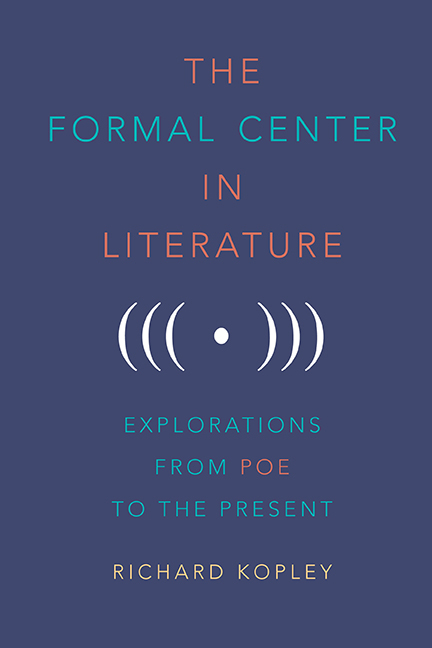Book contents
- Frontmatter
- Dedication
- Contents
- Acknowledgments
- Introduction
- 1 “Mournful and Never-Ending Remembrance” in Edgar Allan Poe's The Narrative of Arthur Gordon Pym
- 2 Retracing Our Steps in Edgar Allan Poe's “The Man of the Crowd”
- 3 “Scrutinizing the Parchment More Closely”: The Form of “The Gold-Bug” and Its Relationship to That of the Dupin Tales
- 4 Form and Reform in Nathaniel Hawthorne's “Earth's Holocaust”
- 5 The Circle and Its Center in Herman Melville's “Bartleby, the Scrivener”
- 6 Chiasmus in Henry David Thoreau's Walden
- 7 The Mythological Centers of Lewis Carroll's Alice Books
- 8 Table as Text in James Joyce's “The Dead”
- 9 The Structure of Sherwood Anderson's “Hands”
- 10 The Architecture of Ernest Hemingway's “The Three-Day Blow”
- 11 Balance in Dashiell Hammett's The Maltese Falcon
- 12 Framing Caesar in Raymond Chandler's The Big Sleep
- 13 The Ridge of the Domino in Patricia Highsmith's Strangers on a Train
- 14 The “X in the Air” in Joyce Carol Oates's “Where Are You Going, Where Have You Been?”
- 15 The Hybrid Center of Zadie Smith's White Teeth
- Notes
- Bibliography
- Index
9 - The Structure of Sherwood Anderson's “Hands”
Published online by Cambridge University Press: 14 June 2019
- Frontmatter
- Dedication
- Contents
- Acknowledgments
- Introduction
- 1 “Mournful and Never-Ending Remembrance” in Edgar Allan Poe's The Narrative of Arthur Gordon Pym
- 2 Retracing Our Steps in Edgar Allan Poe's “The Man of the Crowd”
- 3 “Scrutinizing the Parchment More Closely”: The Form of “The Gold-Bug” and Its Relationship to That of the Dupin Tales
- 4 Form and Reform in Nathaniel Hawthorne's “Earth's Holocaust”
- 5 The Circle and Its Center in Herman Melville's “Bartleby, the Scrivener”
- 6 Chiasmus in Henry David Thoreau's Walden
- 7 The Mythological Centers of Lewis Carroll's Alice Books
- 8 Table as Text in James Joyce's “The Dead”
- 9 The Structure of Sherwood Anderson's “Hands”
- 10 The Architecture of Ernest Hemingway's “The Three-Day Blow”
- 11 Balance in Dashiell Hammett's The Maltese Falcon
- 12 Framing Caesar in Raymond Chandler's The Big Sleep
- 13 The Ridge of the Domino in Patricia Highsmith's Strangers on a Train
- 14 The “X in the Air” in Joyce Carol Oates's “Where Are You Going, Where Have You Been?”
- 15 The Hybrid Center of Zadie Smith's White Teeth
- Notes
- Bibliography
- Index
Summary
SHERWOOD ANDERSON described his writing of “Hands” as “the greatest moment of my life.” He reports that once he finished the story he said to himself, “It is solid. It is like a rock. It is there. It is put down.” Elsewhere he states that he thought, similarly, “It's there. It's solid. It will stand there like a rock. If no one else knows, I know.” And yet again: “It's there. It's solid. It does not matter if anyone else ever understands all of the implications of my story, it is nonetheless sound.” In one version he describes himself as calling out his window, after writing “Hands”:
They may go to hell.
Who?
Well, never mind who.
All who say that this tale is not authentic, that it is not solid, having structure, beauty, strength.
What, we may ask, are those “implications”; what is that “structure”? After all, he did write, in A Story Teller's Story, “What was wanted I thought was form, not plot, an altogether more elusive and difficult thing to come at.” Did he find it in “Hands”? We may carefully attend to suggestive parallel phrasing: we may follow scholars who have noted the symmetry of the beginning and the end of the story, progress inward from that symmetry, and find further symmetry and then the defining center.
“Hands” is a much-taught, tender tale about love and fear. A young teacher, Adolph Myers, conveys his encouragement of the boys who are his students with a touch or caress. A student's false accusation (made, ironically, because of imaginings, “dreams” [15]) prompts fear in the parents, one of whom therefore beats the teacher. Threatened with hanging by a group of angry men, a traumatized Adolph Myers flees, not understanding what has happened, not having had any conscious sexual purpose. Renamed Wing Biddlebaum, he lives on the edge of Winesburg, Ohio, for twenty years, fearful of his hands and their possible expression. His feeling for the inner world of his students—for their dreaming—remains, and he expresses it to young George Willard, an aspiring writer. Wing Biddlebaum is a gentle, puzzled, endearing man—to use Anderson's language, he is a lovable “grotesque” (9), a sweet “twisted apple” (19, 21). But Anderson's comments on the joy of writing “Hands” point us beyond the author's wonderful character to his wonderful artistry.
- Type
- Chapter
- Information
- The Formal Center in LiteratureExplorations from Poe to the Present, pp. 75 - 82Publisher: Boydell & BrewerPrint publication year: 2018



